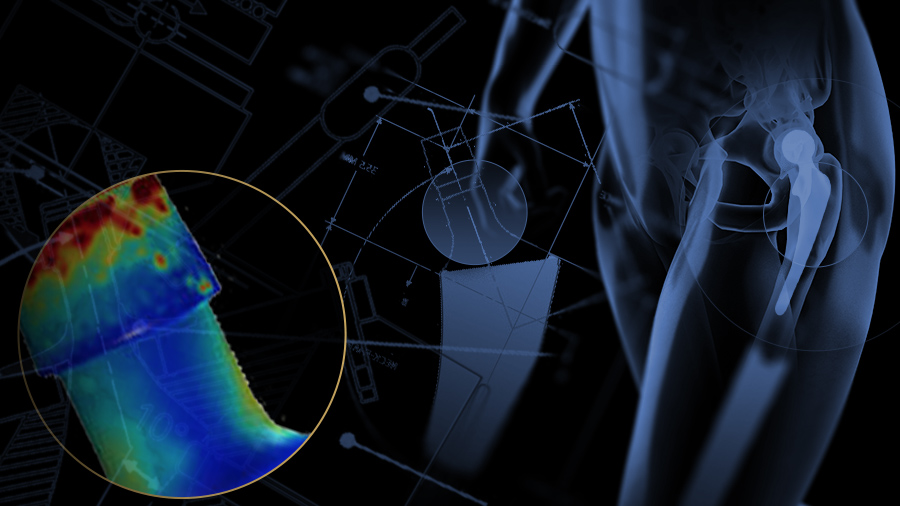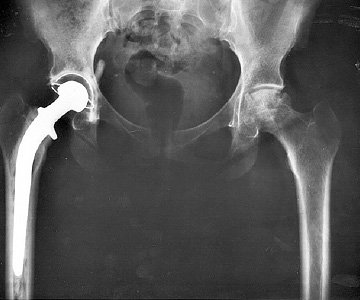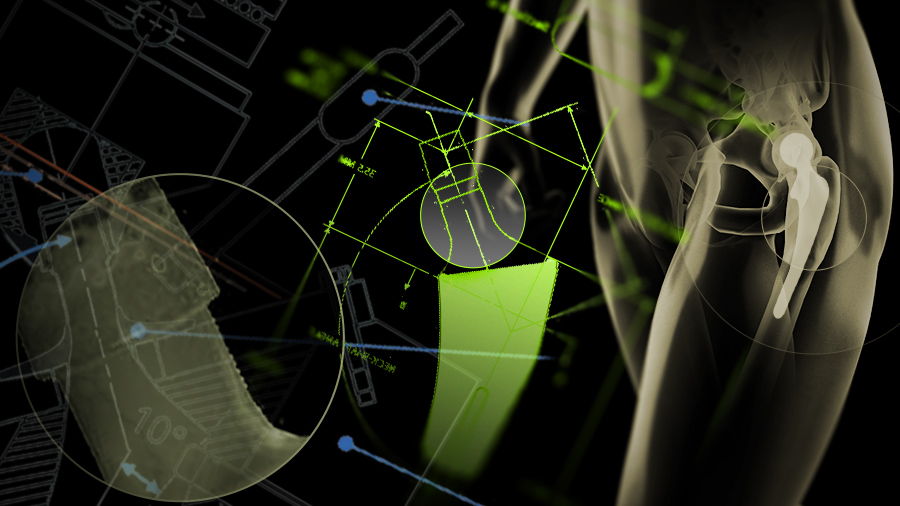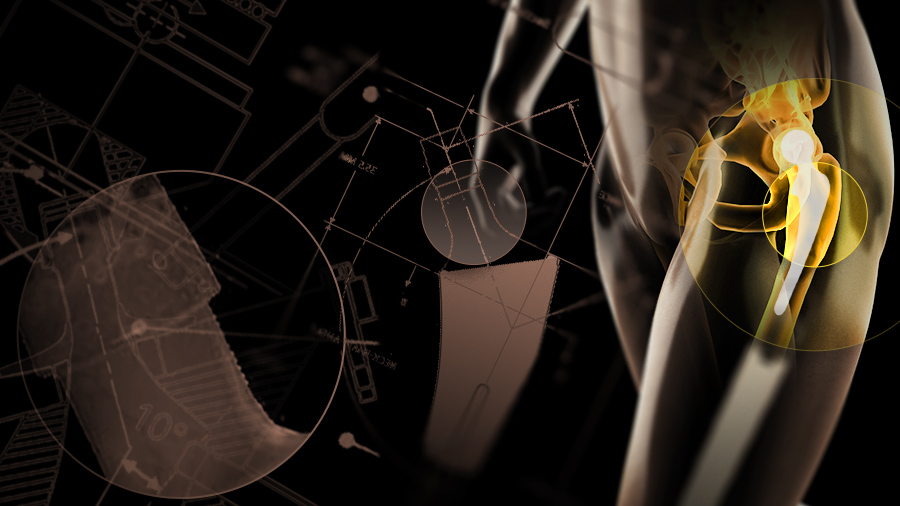Risk factors for taper corrosion in total hip arthroplasty
Preview
Research continues towards a better understanding of total hip arthroplasty taper corrosion in modular connections between metal device components. Corrosion has mainly been documented in metal-on-metal joint articulations but a growing number of cases involving metal-on-polyethylene have arisen. Metal debris due to corrosion and wear, loosened by mechanical stress inherent in the design of modular tapers, appears to be the source of clinical symptoms, such as elevated serum metal ions, local tissue reaction, and implant failure. We look at a number of suspected factors that, when combined in vivo, have contributed to the problem.
Hip joint replacement is the most common orthopedic joint surgery [1]. In the EU it is the second most common surgical procedure after Caesarean sections [2]. Rates for total hip arthroplasty (THA) are growing around the world and younger patients are undergoing the procedure; the American Academy of Orthopedic Surgeons (AAOS) reported a 123 percent increase between 2000 and 2009 in the 45 to 64 age group. While women are more likely to be recipients of an artificial hip, it has been estimated that more than 2.5 million Americans are living with this implant [3], with a further 300,000 Americans and more than 80,000 people in the UK receiving new hips each year [4].
Metal modularity
Considering the frequency with which THA is performed, any tool that can assist surgeons with their tasks in the operating room, whether it be for primary or revision surgery, are usually welcome additions. Introduced in the 1980s and 1990s, modular implants were thought to help surgeons customize biomechanics. Modular implant pieces facilitated an easier achievement of offset, limb length, and anteversion, which is a complex endeavor [5].
The introduction of modular metal-on-metal total hip joint articulations with large heads (MoM THA) was seen as an opportunity and promoted by most device companies, embraced by many surgeons and as a result, a significant number of patients received this combination. Modular MoM THA appeared to be a great solution to stability issues, and an alternative to resurfacing, particularly for revisions due to failed femoral neck fracture [6].
It’s been asserted that surgeons only contemplate the strength of a material when choosing a modular junction. But this single consideration neglects a “totality of factors”, such as corrosion resistance, cost, and manufacturing constraints [7]. When it comes to selecting a femoral head, cobalt/chromium (Co/Cr) alloys are low cost and also strong, which are desirable features [8]. Coupled with the advantages of modular design (intraoperative flexibility, simplified procedures, decreased inventory) it is easy to see why modular metal implants are handy in the toolbox.
However, corrosion at the taper junction in modular hip implants is increasingly suspected to contribute to mortality, adverse tissue reaction, such as pseudotumors, and device failure [7, 8, 9, 10], regardless of the type of articulating bearing surface used [11]. One recalled modular head-neck stem implant has had reported failure rates of 86 percent within three to five years [12].
Read the full article with your AO login
- Indications of trouble
- A slow call to action
- Corrosion through a combination of risk factors
- Devices
- Patients
- Installation
- A complex problem
- Interview with Michael Morlock
- First observations
- Predominant risk factors
- Vulnerable patients and products
- Corrosion issues in other joint replacements
- Needed changes in surgical practice and implant design
- References
Additional AO resources
Access videos, tools, and other assets to learn more about this topic.
- Upcoming events: AO Recon Course finder
Contributing experts
This series of articles was created with the support of the following specialists (in alphabetical order):

Moussa Hamadouche
Cochin University Hospital
Paris, France

Michael Morlock
Hamburg University of Technology
Hamburg, Germany

Carsten Perka
Charité—University Medicine Berlin
Berlin, Germany
This issue was created by Word+Vision Media Productions, Switzerland
References
- Wikipedia. Hip Replacement. Available at: https://en.wikipedia.org/wiki/Hip_replacement Accessed October 17, 2016.
- Eurostat. Surgical operations and procedures statistics. Available at: http://ec.europa.eu/eurostat/statistics-explained/index.php/
Surgical_operations_and_procedures_statistics #Notes Accessed October 17, 2016. - American Academy of Orthopedic Surgeons. 2.5 million Americans living with an artificial hip, 4.7 million with an artificial knee. Available at: http://newsroom.aaos.org/media-resources/
Press-releases/25-million-americans-living-with-an-artificial-hip- 47-million-with-an-artificial-knee.htm Accessed October 17, 2016. - Marques EM, Humphriss R, Welton NJ, et al. The choice between hip prosthetic bearing surfaces in total hip replacement: a protocol for a systematic review and network meta-analysis. Syst Rev. 2016 Feb 1;5:19.
- Duwelius PJ, Burkhart B, Carnahan C, et al. Modular versus nonmodular neck femoral implants in primary total hip arthroplasty: which is better? Clin Orthop Relat Res. 2014 Apr;472(4):1240-1245.
- Morlock M. The taper disaster-How could it happen? Hip Int. 2015 Jul-Aug;25(4):339-346.
- McTighe T, Brazil D, Clarke I. Metallic modular taper junctions in total hip arthroplasty. Reconstructive Review. 2015 Jul;5(2). Available at: www.reconstructivereview.org/ojs/
index.php/rr/article/viewFile/108/119 . Accessed October 18, 2016. - Wyles C, McArthur B, Wagner ER. Ceramic femoral heads for all patients? An argument for cost containment in hip surgery. Am J Orthop (Belle Mead NJ). 2016 Oct;45(6).
- Chana R, Esposito C, Campbell PA, et al. Mixing and matching causing taper wear: corrosion associated with pseudotumour formation. J Bone Joint Surg Br. 2012;94(2):281-286.
- Cooper HJ. The local effects of metal corrosion in total hip arthroplasty. Orthop Clin N Am. 2014 Jan;45(1):9-18.
- Silverton CD, Jacobs JJ, Devitt JW, et al. Midterm results of a femoral stem with a modular neck design: clinical outcomes and metal ion analysis. J Arthroplasty. 2014 Sep;29(9):1768-1773.
- Jennings J, Dennis D, Yang C. Corrosion of the head-neck junction after total hip arthroplasty. J Am Acad Orthop Surg. 2016 Jun;24(6):349-356.
- Bernstein DT, Meftah M, Paranilam J, et al. Eighty-six percent failure rate of a modular-neck femoral stem design at 3 to 5 years: Lessons learned. J Bone Joint Surg Am. 2016 Jun 15;98(12):e4..
- National Joint Registry. 7th Annual Report for England, Wales, Northern Ireland and the Isle of Man. 2010. Available at: www.njrreports.org.uk; www.njrcentre.org.uk . Accessed October 18, 2016.
- Garbuz DS, Tanzer M, Greidanus NV. The John Charnley Award: Metal-on-metal hip resurfacing versus large-diameter head metal-on-metal total hip arthroplasty: a randomized clinical trial. Clin Orthop Relat Res. 2010 Feb;468(2):318-325.
- European Union Scientific Committee on Emerging and Newly Identified Health Risks (2011). Opinion on the safety of Metal-on-Metal joint replacements with a particular focus on hip implants. Available at: http://ec.europa.eu/health/
scientific_committees/emerging/docs/scenihr_o_042.pdf Accessed October 18, 2016. - Goldberg J, Gilbert J, Jacobs J, et al. A multicenter retrieval study of the taper interfaces of modular hip prostheses. Clin Orthop Relat Res. 2002 Aug;(401):149-161.
- Windler M. [Corrosion behaviour of modular interconnects in total hip prostheses]. ETH Zürich. Dissertation. 2003. [In German].
- Hansen D. Metal corrosion in the human body: The ultimate bio-corrosion scenario. Interface. 2008 Summer;17(2):31-35.
- Cartner J. Factors that influence taper corrosion: Learning from an 18-year retrieval database. Presented at: European Hip Society Annual Congress; 2014 Oct 9-11; Stockholm. Available at: http://www.healio.com/orthopedics/hip/
news/print/orthopaedics-today-europe/ %7Baa72a5f3-6b3b-4775-bd50-99ab953f1c26%7D/ head-size-and-time-in-vivo-do-not-correlate-with -tha-implant-taper-corrosion. Accessed October 10, 2016. - Morlock M, Bünte D, Gührs J, et al. Corrosion of the head-stem taper junction—Are we on the verge of an epidemic? HSS J. 2016 Oct;12(3).
- McGrory BJ, McKenney BR. Revision for taper corrosion at the head-neck junction: pearls and pitfalls. Curr Rev Musculoskelet Med. 2016 Mar;9(1):97-102.
- Whittaker RK, Hothi HS, Eskelinen A. The variation in taper surface roughness for a single design effects the wear rate in total hip arthroplasty. J Orthop Res. 2016 Oct. doi: 10.1002/jor.23456. [Epub ahead of print]
- Pourzal R, Hall DJ, Ha NQ, et al. Does surface topography play a role in taper damage in head-neck modular junctions? Clin Orthop Relat Res. 2016 Oct;474(10):2232-2242.
- World Health Organization. Obesity and overweight fact sheet. Available at: http://www.who.int/mediacentre/
factsheets/fs311/en/ Accessed October 19, 2016. - Workgroup of the American Association of Hip and Knee Surgeons Evidence Based Committee. Obesity and total joint arthroplasty: a literature based review. J Arthroplasty. 2013 May;28(5):714-721.
- Ritter MA, Davis KE, Meding JB, et al. The effect of alignment and BMI on failure of total knee replacement. J Bone Joint Surg Am. 2011;93(17):1588.
- Higgs GB, Hanzlik JA, MacDonald DW, et al. Is increased modularity associated with increased fretting and corrosion damage in metal-on-metal total hip arthroplasty devices?: a retrieval study. J Arthroplasty. 2013 Sep;28(8 Suppl):2-6.
- Donaldson FE, Coburn JC, Siegel KL. Total hip arthroplasty head-neck contact mechanics: a stochastic investigation of key parameters. J Biomech. 2014 May 7;47(7):1634-1641.
- Hussenbocus S, Kosuge D, Solomon LB. Head-neck taper corrosion in hip arthroplasty. BioMed Research International. 2015. Article ID 758123. Available at: https://www.hindawi.com/journals/bmri/2015/758123/ Accessed October 19, 2016.
- National Joint Registry. 13th Annual Report for England, Wales, Northern Ireland and the Isle of Man. 2016. Available at: http://www.njrreports.org.uk/Portals/0/PDFdownloads/
NJR%2013th%20Annual%20Report%202016.pdf ) Accessed October 19, 2016.





